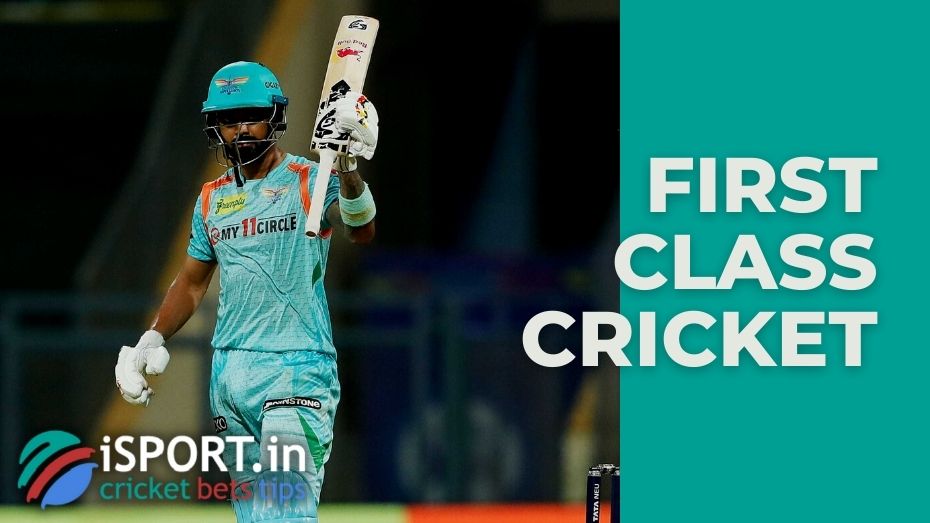First-class cricket: what is it?

When determining the level of a match in cricket, there is a particular requirement that must be met by club meetings. Only the best teams can take part in some tournaments, and some are created specifically for beginners. First-class cricket, as the name implies, is the official qualification of international and national top-level matches.
First-Class Cricket: Regulations
There are a number of factors that affect whether or not a cricket match played at the first-class level is of the highest quality. To summarize, this is a competition that takes place between teams that satisfy a certain criteria and lasts for three days or longer. It is expected that each team will have eleven players, and the tournament itself should let teams to play two innings (although it is not uncommon for there to be less innings played in the end).
There are three types of cricket that are considered to be the standard form: Twenty20, List A, and First-class cricket. The term itself is unknown, but it is absolutely clear that it was used long before the qualifications acquired official status. Test cricket is one of the numerous forms of first-class cricket, although there are also many more forms.
First-Class Cricket: From the Beginnings To the Present Day
The sport of cricket went through a very lengthy history up to the point when the phrase “first-class cricket” was recognized. Despite the fact that it was used even in freestyle, it did not exist as an official status until the year 1894. It was common practice to refer to a contest of high quality as a first-class cricket match. On the other hand, the use of the phrase “first-class” was not required in order to accomplish this. The words “important” and “large” as well as any other adjectives that are comparable were appropriate.
Due to the fact that the notion had not yet been formed, any match that included senior county clubs in the United Kingdom was referred to as “first-class” for a considerable amount of time. The fact that there were not a lot of major clubs meant that nobody was in a rush to settle on the precise phraseology.
However, as time went on, cricket got more popular, which resulted in the challenge of categorizing first-class matches being that much more difficult to solve. As a result, after meetings with the secretaries of the clubs participating in the County Championship, it was decided to give the term “first-class” official status. Officially, the first first-class match took held at Lord’s Stadium in the 1895 season between MMC and Nottinghamshire. The former team beat Nottinghamshire by a score of 37 rounds to the latter.
The International Cricket Council (ICC) ultimately came up with the idea of “First Class Cricket” in May of 1947. In addition, the council determined that the term should not have a retrospective effect. The term “first-class” was initially used to refer to matches that lasted for three days or more and used eleven players from each of the two teams. However, it is important to note that the teams themselves should also be considered “first-class.” Any item that does not fulfill these criteria is not deemed to be of “first-class” significance. It is possible for the governing authorities of cricket in each nation to decide the status of an individual team.
Thus, the ICC has given international recognition to the MCC’s definition as early as 1894.
By the way, the 60,000th first-class cricket match was played during the 2019-2020 Ranji Trophy season.
It is interesting to note that statisticians still have a difficulty determining which matches over the whole history of cricket are deemed to be “first-class.” This is because the International Cricket Council does not have any form of rules in place. At the same time as some statisticians are of the opinion that older matches should not be included in this category.
There are others who are of the opinion that all high-quality games throughout history should be included. It goes without saying that differing opinions of this kind do not have any impact on the way the game is played or the way matches are organized. Consequently, this issue is occurring despite the fact that just a certain group of individuals are interested in it.
First-Class Cricket: When a Match Is Considered First-Class
It is not a simple task to ascertain whether or not a certain match is classified as First-class cricket. In addition to the requirements that we stated above, there are a great many more that apply to this.
Therefore, we will try to concretize these criteria, taking into account the definition put forward by the ICC:
- One of the main and strict definitions of a first-class match must be played at least three days on the schedule. Otherwise, the qualifications will be completely different.
- Each of the teams participating in the game must have eleven players.
- The number of innings each side can have is two.
- The stadium where the match can be must meet certain criteria. In particular, the “first-class” game is played on the natural lawn only.
- The match must fully comply with accepted cricket rules, but only minor local adjustments are allowed.
The definition of “test match” is also introduced. It is considered a “first-class match” between two teams whose countries are full ICC members.
By the way, Indian bookmakers love to offer players a wide line of listings for first-class matches. Here you can find various bonuses and promocodes that will make your sports betting (and not only spectacular cricket tournaments) even more enjoyable.
